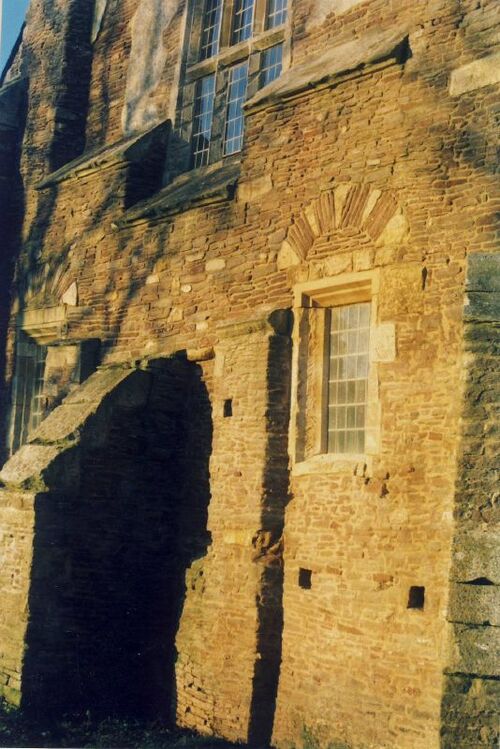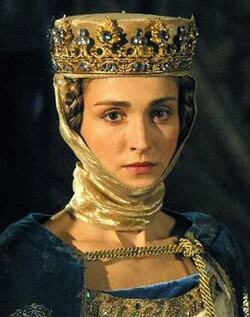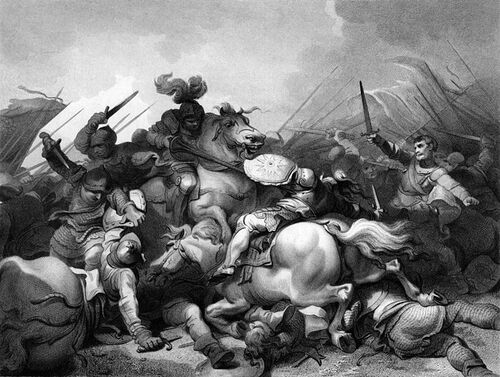-
Today in Tudor History...
20 August 1467 – The Second Battle of Olmedo takes places as part of a succession conflict between Henry IV of Castile and his half-brother Alfonso, Prince of Asturias.
1509 – Birth of Sir William Stanford , judge and legal writer.
1589 - Marriage of James VI of Scotland and Anne of Denmark by proxy at Kronborg Castle, Helsingør, Denmark.

1599 - Death of Sir Thomas Norris, English soldier, made Lord President of Munster in Ireland
21 August 1157 –Birth of Alfonso VII of León and Castile
1271 –Birth of Alphonse, Count of Poitiers
1535 - On Saturday 21 August 1535, Henry VIII and Anne Boleyn visited Nicholas Poyntz at Acton Court, Iron Acton, Gloucestershire. Poyntz had built a special new lodging for his royal guests which still survives. It contained three first floor state rooms and one of these still has painted decoration by an artist of the Tudor court. These state rooms connected to the older house by a covered walkway called a 'pentice.' Archaeological excavations found fragments of precious Venetian glass and maiolica which Nicholas probably bought for the visit. The evidence of lengthy preparations by Nicholas at Acton shows that Henry's progress in the west of England was planned in advance


Acton Court is a recently restored Tudor house on Latteridge Lane, Iron Acton, South Gloucestershire, England. It is a Grade I listed building.
The Poyntz family owned the property from 1364 until 1680. Nicholas Poyntz (died 1557) added the East Wing onto the existing moated manor house shortly before 1535. Construction took about 9 months to complete. Subsequently, the wing was lavishly and fashionably decorated to impress Henry VIII. The king and his second wife, Anne Boleyn, stayed in the house in 1535, during a tour of the West Country. Building work continued at Acton Court until Nicholas died in 1557.
When the direct line of succession ended in 1680, the house was sold. It was reduced in size and converted for use as a tenanted farmhouse. Due to neglect, the house gradually fell into a dilapidated state. By the end of the 20th century, practically only the East Wing survived. However, the neglect resulted in a rare example of Tudor royal state apartments being preserved virtually intact. An extensive restoration was completed only recently.
Prior to the restoration, English Heritage commissioned a comprehensive study, published as K. Rodwell and R. Bell, Acton Court: The evolution of an early Tudor courtier's house (2004).
source:wikipedia


22 August 1304 – Death of John II, Count of Holland
1350 – Death of Philip VI of France
1358 –Death of Isabella of France


1412 – Death of Frederick II, Elector of Saxony

1456 – Death of Vladislav II of Wallachia
1485 – Death of Richard III of England

1485 – The Battle of Bosworth Field, the death of Richard III and the end of the House of Plantagenet.

The Battle of Bosworth Field was the last significant battle of the Wars of the Roses, the civil war between the Houses of Lancaster and York that raged across England in the latter half of the 15th century. Fought on 22 August 1485, the battle was won by the Lancastrians. Their leader Henry Tudor, Earl of Richmond, by his victory became the first English monarch of the Tudor dynasty. His opponent, Richard III, the last king of the House of York, was killed in the battle. Historians consider Bosworth Field to mark the end of the Plantagenet dynasty, making it a defining moment of English and Welsh history.
Richard's reign began in 1483 when he was handed the throne after his twelve-year-old nephew Edward V, for whom he was acting as Lord Protector, was declared illegitimate and ineligible for the throne. The boy and his younger brother disappeared in mysterious circumstances, and Richard's support was eroded by rumours of his involvement in the death of his wife. Across the English Channel in Brittany, Henry Tudor, a descendant of the greatly diminished House of Lancaster, seized on Richard's difficulties so that he could challenge Richard's claim to the throne. Henry's first attempt to invade England was frustrated by a storm in 1483, but at his second attempt he arrived unopposed on 7 August 1485 on the southwest coast of Wales. Marching inland, Henry gathered support as he made for London. Richard mustered his troops and intercepted Henry's army south of Market Bosworth in Leicestershire. Thomas, Lord Stanley, and Sir William Stanley brought a force to the battlefield, but held back while they decided which side it would be more advantageous to support.
Richard divided his army, which outnumbered Henry's, into three groups (or "battles"). One was assigned to the Duke of Norfolk and another to the Earl of Northumberland. Henry kept most of his force together and placed it under the command of the experienced Earl of Oxford. Richard's vanguard, commanded by Norfolk, attacked but struggled against Oxford's men, and some of Norfolk's troops fled the field. Northumberland took no action when signalled to assist his king, so Richard gambled everything on a charge across the battlefield to kill Henry and end the fight. Seeing the king's knights separated from his army, the Stanleys intervened; Sir William led his men to Henry's aid, surrounding and killing Richard. After the battle, Henry was crowned king below an oak tree in nearby Stoke Golding, now a residential garden.
Henry hired chroniclers to portray his reign favourably; the Battle of Bosworth was popularised to represent the Tudor dynasty as the start of a new age. From the 15th to 18th centuries the battle was glamorised as a victory of good over evil. The climax of William Shakespeare's play Richard III provides a focal point for critics in later film adaptations. The exact site of the battle is disputed because of the lack of conclusive data, and memorials have been erected at different locations. The Bosworth Battlefield Heritage Centre was built, in 1974, on a site chosen based on a theory that has since been challenged by several scholars and historians. In October 2009, a team of researchers, who had performed geological surveys and archaeological digs in the area from 2003, suggested a location two miles (3.2 km) southwest of Ambion Hill.
1532-Death of Richard Warham.He was the Archbishop of Canterbury from 1503 to his death.
1545-Death of Charles Brandon, 1st Duke of Suffolk.He was the son of Sir William Brandon and Elizabeth Bruyn. Through his third wife Mary Tudor he was brother-in-law to Henry VIII. His father was the standard-bearer of Henry Tudor, Earl of Richmond (later King Henry VII) and was slain by Richard III in person at the battle of Bosworth Field. Suffolk died of unknown causes at Guildford.Before 7 February 1507 he married Margaret Neville.In early 1508 in a secret ceremony at Stepney, and later publicly at St Michael's, Cornhill, he married Margaret Neville's niece, Anne Browne .He contracted to marry Elizabeth Grey, 5th Baroness Lisle. He was thus created 1st Viscount Lisle of the third creation in 1513, but the contract was annulled, and he surrendered the title before 1519 or in 1523.In May 1515 he married Mary Tudor, Queen Dowager of France , by whom he had two sons who died young, and two daughters:Frances,mother of Jane Grey and Eleanor.On 7 September 1533 he married Catherine Willoughby, 12th Baroness Willoughby de Eresby , by whom he had two sons, both of whom died young of the sweating sickness

1552 - Edward VI visits Christchurch on his royal progress.

1535 - Anne Boleyn and Henry VIII visited the Walsh family at Little Sodbury Manor in the village of Little Sodbury, South Gloucestershire.

From Nicholas Kingsley, The Country Houses of Gloucestershire: Volume One, 1500-1660 (London and Frome, 2001), p. 137-8:
’The house occupies a dramatic position on the westward-facing escarpment of the Cotswold, and enjoys spectacular views over South Gloucestershire, but has paid for its exposed position by being twice struck by lightning, with consequent effects on its architectural history.
The Stanshawe family would seem to have been resident at Little Sodbury by c.1430, and the existing hall may be almost that early. It is remarkably lofty, having an open timber roof with four tiers of windbraces. A partially restored wooden screen still divides the hall proper from the screens passage. Above this a closely-studded timber partition conceals a large room (as at Buckland rectory). The oriel window in the east wall is an original feature reconstructed during the early 20th century using much of the original stonework.
In about 1491, Little Sodbury passed by marriage into the hands of John Walsh of Olveston, who became the Crown’s receiver for the Berkeley family estates, and prospered mightily under royal favour. His son, Sir John, was the King’s champion at the coronation of Henry VIII in 1509, and subsequently employed William Tyndale as tutor to his children: Tyndale’s translation of the Bible may have been begun at Little Sodbury. Either Sir John Walsh or his father added the block to the right of the porch, with its charming first-floor oriel windows, and also altered the buildings north of the hall.
In 1608 the manor of Little Sodbury was sold to Thomas Stephens, who was attorney to the royal children, Prince Henry and Prince Charles, and who amassed a vast patrimony which he divided between his three sons. Edward Stephens received Little Sodbury and the adjoining estates of Lyegrove and, at sometime around 1630-40, added the stair case south of the hall and redecorated the rooms in the south wing to which it gave better access. Several of these rooms still have fine chimneypieces, and there was once another which was subsequently removed to Lyegrove, where it graces the entrance hall.....’

1553 - Stephen Gardiner, Bishop of Winchester, was made Lord Chancellor by Mary I.

1553 – Death of John Dudley, 1st Duke of Northumberland, English general, admiral, and politician, who led the government of the young King Edward VI from 1550 until 1553, and unsuccessfully tried to install Lady Jane Grey on the English throne after the King's death. The son of Edmund Dudley, a minister of Henry VII executed by Henry VIII, John Dudley became the ward of Sir Edward Guildford at the age of seven. He grew up in Guildford's household together with his future wife, Guildford's daughter Jane, with whom he was to have 13 children. Dudley served as Vice-Admiral and Lord Admiral from 1537 until 1547, during which time he set novel standards of navy organisation and was an innovative commander at sea. He also developed a strong interest in overseas exploration. Dudley took part in the 1544 campaigns in Scotland and France and was one of Henry VIII's intimates in the last years of the reign. He was also a leader of the religious reform party at court.
In 1547 Dudley was created Earl of Warwick and, with the Duke of Somerset, England's Lord Protector, distinguished himself in the renewed Scottish war at the Battle of Pinkie. During the country-wide uprisings of 1549 Dudley put down Kett's Rebellion in Norfolk. Convinced of the Protector's incompetence, he and other privy councillors forced Somerset out of office in October 1549. Having averted a conservative reaction in religion and a plot to destroy him alongside Somerset, Dudley emerged in early 1550 as de facto regent for the 12-year-old Edward VI. He reconciled himself with Somerset, who nevertheless soon began to intrigue against him and his policies. Somerset was executed on largely fabricated charges, three months after Dudley had been raised to the Dukedom of Northumberland in October 1551.
As Lord President of the Council, Dudley headed a distinctly conciliar government and sought to introduce the adolescent King into business. Taking over an almost bankrupt administration, he ended the costly wars with France and Scotland and tackled finances in ways that led to some economic recovery. To prevent further uprisings he introduced countrywide policing on a local basis, appointing Lords Lieutenants who were in close contact with the central authority. Dudley's religious policy was—in accordance with Edward's proclivities—decidedly Protestant, further enforcing the English Reformation and promoting radical reformers to high Church positions.
The 15-year-old King fell ill in early 1553 and excluded his half-sisters Mary and Elizabeth, whom he regarded as illegitimate, from the succession, designating non-existent, hypothetical male heirs. As his death approached, Edward changed his will so that his Protestant cousin Jane Grey, Northumberland's daughter-in-law, could inherit the Crown. To what extent the Duke influenced this scheme is uncertain. The traditional view is that it was Northumberland's plot to maintain his power by placing his family on the throne. Many historians see the project as genuinely Edward's, enforced by Dudley after the King's death. The Duke did not prepare well for this occasion. Having marched to East Anglia to capture Princess Mary, he surrendered on hearing that the Privy Council had changed sides and proclaimed Mary as Queen. Convicted of high treason, Northumberland returned to Catholicism and abjured the Protestant faith before his execution. Having secured the contempt of both religious camps, popularly hated, and a natural scapegoat, he became the "wicked Duke"—in contrast to his predecessor Somerset, the "good Duke". Only since the 1970s has he also been seen as a Tudor Crown servant: self-serving, inherently loyal to the incumbent monarch, and an able statesman in difficult times.

1559 – Bartolomé Carranza, Spanish archbishop, is arrested for heresy.
1572 – Death of Thomas Percy, 7th Earl of Northumberland, English leader of the Rising of the North(The Rising of the North of 1569, also called the Revolt of the Northern Earls or Northern Rebellion, was an unsuccessful attempt by Catholic nobles from Northern England to depose Queen Elizabeth I of England and replace her with Mary, Queen of Scots.) .He was executed for treason
source:wikipedia
